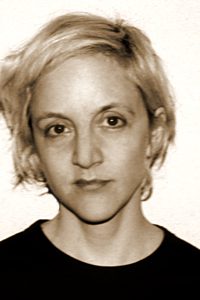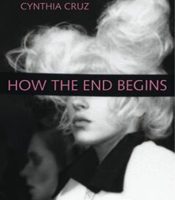Cynthia Cruz’s fourth collection, How The End Begins, is a swirling book of short, vivid poems on similar themes. In fact, it’s really one long poem, divided into many sections. The sections frequently have the same titles, and repetition is key to the book as a whole—“I repeat what I cannot bear,” Cruz writes in “Fatigue Empire”. Its rhythm, its emotional drive, its thematic unfurling, all are revealed as the book progresses through repeated imagery, repeated memory, and repeated language.
It might be rash to say that the poems only work in order, but they definitely work well in order, and after reading them thusly I couldn’t imagine reading them otherwise. Each poem links up—in tone, in cadence, in metaphor—with its antecedent(s). Indeed, it’s hard to suggest reading any but a few of the poems on their own (or, perhaps, hard to imagine them being as effective as they are here). As it is, the narrative is a weaving of dreams and visions, drugs, madness, the ups and downs, days of light and of darkness, of a depressive, or of a madwoman.
In the notes in the back of the book, Cruz talks about “connecting referents” in the Lars Von Trier film Melancholia, and that is a primary technique used here. The poems converse with one another, calling out to and answering each other. Some common imagery includes: bee hives, boxes, the color white, snow, glass, the colors red and pink, angels, and a whole host of religious imagery toward the middle of the book, inspired by Joan of Arc. All of these fall under the larger themes of childhood memory, death, chaos, and personal rebirth.
The opening poem, “Are Then Seen And Pursued”, immediately sets out both rhythm and tone:
Cords of voices are unspooling inside my head.
White-gloved as beekeepers, three men arrive
Removing the pleat of my body.
I dreamed the earth burned down, a bleating
Lamb hungering at the edge, like a dark thought, repeating.
If I can trace the continent of this angel
The string will surely drag me back.
 The book seems to progress from an asylum dream to a religious vision and back to asylum dream. Many poems delve into dark memory while others are descriptions of melancholy, depression, or madness, and the vicissitudes that come with it. Cruz lets us in on the terrible struggle associated with overcoming great sorrow and a loss of surety.
The book seems to progress from an asylum dream to a religious vision and back to asylum dream. Many poems delve into dark memory while others are descriptions of melancholy, depression, or madness, and the vicissitudes that come with it. Cruz lets us in on the terrible struggle associated with overcoming great sorrow and a loss of surety.
“Death By Water”
But I need the darkness
To work with.
What else
Is there
But that fine Numorphan music, what
Other sweet,
Shy boy’s number
Can you give me, please.
Some of the poems strike a rawer chord, more brutally straightforward than dreamy, such as “Self Portrait in a Blue Séance Room” and the immediately following “Prayer”:
Please protect me
From my thinking.
And, please,
Glamoury Genet-like angels:
Come to me.
How can I not
Vanish.
The gleaming palace of my childhood,
Smashed. Once ferocious, now
Just a box
Of broken glass.
Cruz’s language and style reminds me more of a couple poetic prosers than poets. One is Amy Hempel, forceful and terse, and the other is, oddly, Cormac McCarthy. I get the feeling if McCarthy were a poet and a young woman, this is what the verse might look like. Certainly Cruz’s clear-eyed embrace of chaos and madness and dream-like repetition is akin to McCarthy’s.
Cruz is a writer of the humans-are-endlessly-chaotic-in-their-complexity camp, as opposed to those who believe that they are endlessly complex in their simplicity. This sentiment is delivered powerfully throughout the book. “Chaos, my saint / Sweetens my long, dark days,” she writes, in “The Birthday Ceremony”. “The uncanny always comes back.” Chaos, madness, indiscernibility, death (Cruz is constantly imagining her own death and/or funeral), reign over the poems. Little respect is reserved for rationality, order, and demonstration. Dream logic abounds, as does vision narrative.
The imagery is by turns startlingly unique and pedestrian religious. Partly, I think, this is intentional, but after a while all the angels and deserts and saints and crosses blur together. It’s a dream, so a little blur isn’t a bad thing, it’s just that we’ve seen this dream a lot in the past.
The book is actually quite short, but can be read two, three times over in one sitting, the repetitions building on one another, sparking new connections, augmenting each other, contrasting and enhancing.
Cruz explained much of the idea and craft of the book in a 2012 interview with writer Lisa Wells on this very website:
“To begin with: we are all mad, it’s simply a matter of where we are on that continuum. My mind is what saved me, as a child. Thank God, I was able to vanish into the world of my mind.”
Cruz goes on to explain the book’s origins (way back in 2011, and already titled) in three poems that were expanded upon and edited to end up with the new volume. The poems were originally (and remain so) about her Catholic upbringing and childhood memories, and the confusion and sorrow that went with it. “I compress and revise compulsively,” Cruz says. “A kind of compulsive repetition and deletion of parts of the self…until I have a perfect box of words that then stand in for experience, feeling, thought, a kind of perfect diorama, a world in miniature.”
Only it takes more than one to purge oneself, dioramas backed up against dioramas, and achieve the kind of rebirth into chaos Cruz is after:
The galloping horses collapse
At night beneath the stars.
Then the film goes blank.
Sorrow comes on: delicious
Illness that it is.
Every morning
I come back to the theater:
How the end begins? Over and over. Each one slightly different from the last.




